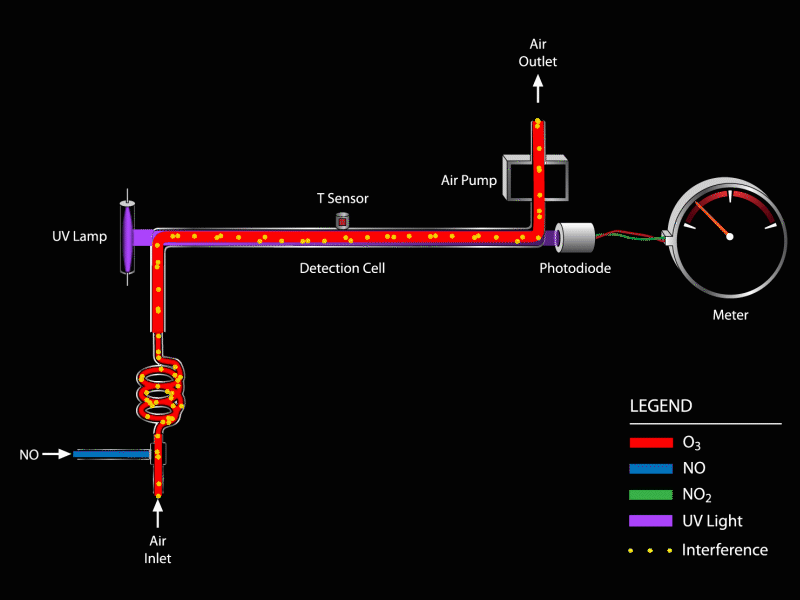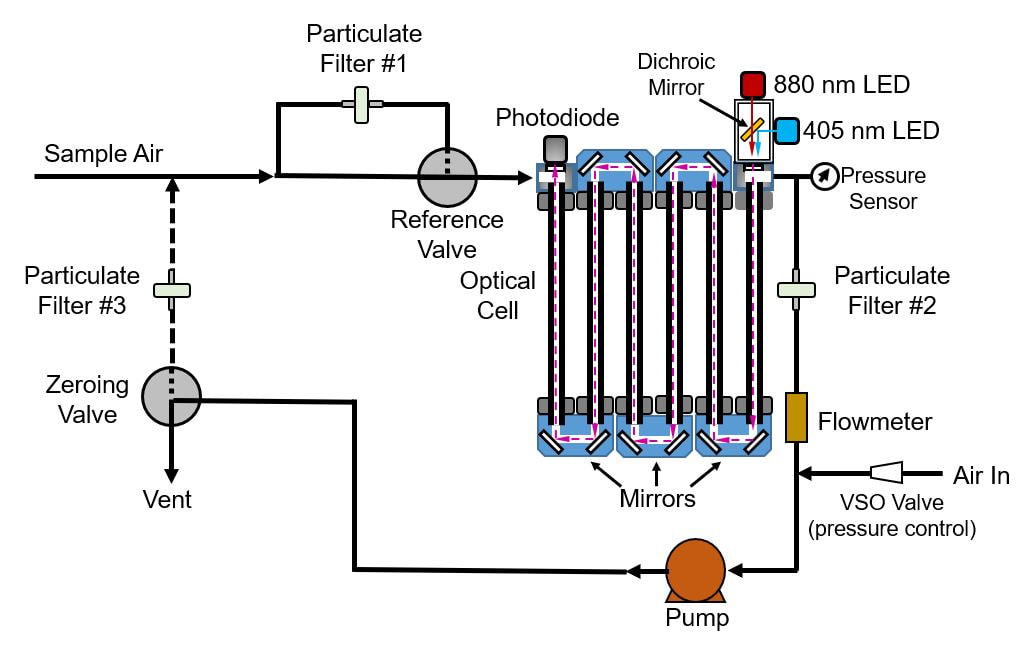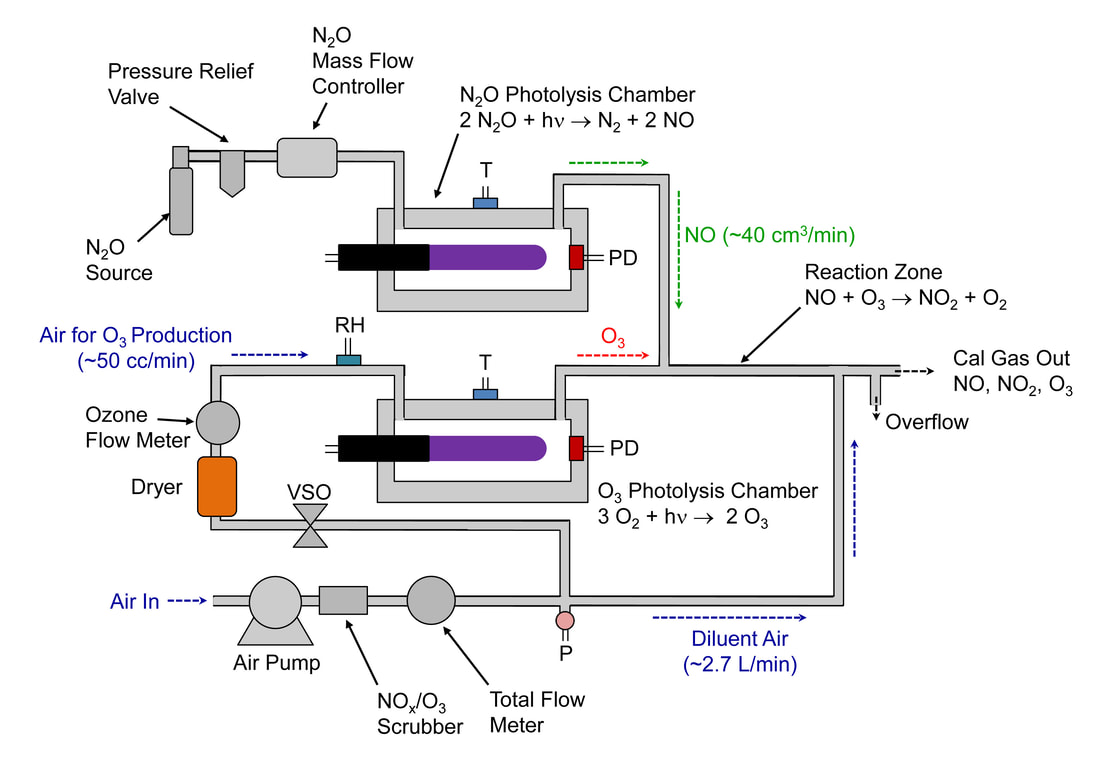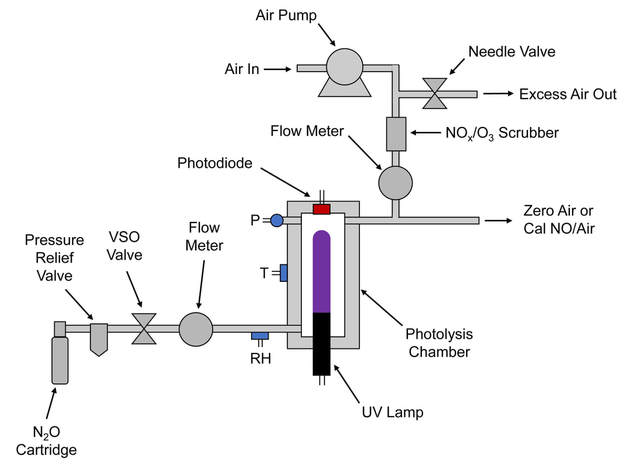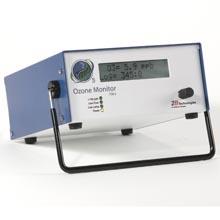
Ozone analyzers all work on the principle of UV radiation absorption.
They allow an accurate measurement of the ozone concentration.
The variety of stratospheric ozone applications at high ozone concentrations at the output of a generator requires a wide range of apparatus and the choice of analyzer suitable for a given application is rarely trivial.
2BTech air analyzers are based on UV absorption, so their measurements are much more accurate than those of electrochemical or semiconductor sensors. The electronic sensors in the 2BTech instruments are designed to react to a wide range of oxidants including hydrogen peroxide, but also to reducing agents such as sulphur dioxide.
UV light absorption has long been used for atmospheric ozone measurements with high accuracy. The ozone molecule has an absorption maximum at 254 nm, coinciding with the main emission wavelength of a low pressure mercury lamp. Fortunately, few molecules found in significant concentrations in the atmosphere absorb at this wavelength. However, interferences, such as organic compounds containing aromatic rings, can occur in highly polluted air.
Ozone is measured by the attenuation of light passing through a 14 cm absorption cell with quartz windows. A low pressure mercury lamp is located on one side of the absorption cell and a photodiode is located on the opposite side of the absorption cell. The photodiode has a built-in interference filter centred at 254 nm, the main wavelength of the light emitted by the mercury lamp. An air pump draws sample air into the instrument at a rate of approximately 1 L/min. A solenoid valve switches to alternately send this air directly into the absorption cell or through an ozone and gas scrubber (activated carbon filter, "Scrubber") and into the absorption cell. The intensity of the light at the photodiode is measured in the air that has passed through the Scrubber (Io) and the air that has not passed through the Scrubber (I).

Our engineers are at your disposal and will help you choose the right analyzer for your application. In addition, we will provide you with accessories to complete your measuring system.
Portable ozone monitors for ambient air
Personal Ozone Monitor (POM)
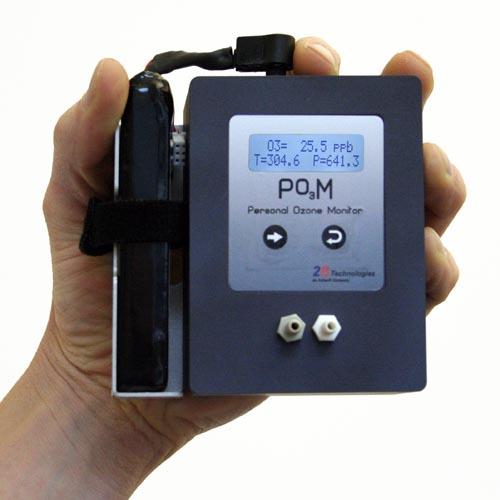
Precise measurements (+/- 2%)
Measures from 0.03 to 10 ppm
Integrated data logger
4-20 mA outputs, RS-232
Compact UV technology
Built-in GPS
Applications:
- Personal exposure monitoring for studies of health effects of air pollutants
- Health and safety monitoring at industrial sites using ozone
- Vertical profiling using balloons, kites, RPVs, and light aircraft where space and weight are highly limited
- Long-term monitoring at remote locations where power is highly limited
- Urban arrays of ground-based detectors
2BTech POM Personal Ozone Monitor
2BTech Monitor 106
We work with the company 2BTech
This company is dedicated to the development and marketing of new analytical instruments for atmospheric and environmental measurements. They specialise in miniaturised instruments for the measurement of ozone (O3), nitrogen monoxide (NO), nitrogen dioxide (NO2), mercury (Hg) and other chemical species in the air.
It is a small company with about 20 employees. The factory is located in Boulder, Colorado, USA. It produces various devices for air analysis using a technique based on UV reflection.
Standard Enclosure

Precise measurements (+/- 2%)
Model L: measurements from 0 to 100 ppm / Model M: measurements from 0 to 1000 ppm / Model H: measurements from 0 to 10 000 ppm
Integrated data logger
4-20 mA outputs, RS-232, relays
UV single beam UV technology.
NEMA Enclosure
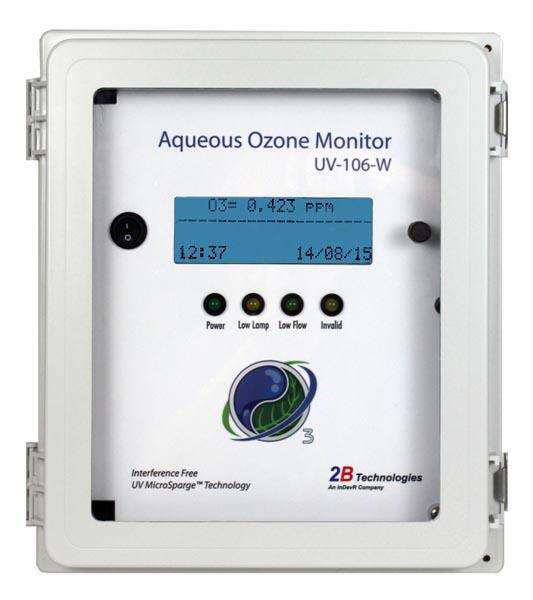
Precise measurements (+/- 2%)
Model L: measurements from 0-100 ppm / Model M: measurements from 0-1000 ppm / Model H: measurements from 0-10'000 ppm
Environmental protection
Built-in data logger / 4-20 mA outputs, RS-232, relay
UV single beam ozone technology.
OEM Version
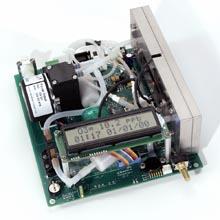 Precise measurements (+/- 2%)
Precise measurements (+/- 2%)
Model L: measurements from 0-100 ppm / Model M: measurements from 0-1000 ppm / Model H: measurements from 0-10'000 ppm
OEM version
Built-in data logger / 4-20 mA outputs, RS-232, relay
UV single beam ozone technology.
Model 108-L Ozone Monitor
The Model 108-L is a low cost ozone monitor that is designed for easy integration into a customer's air monitoring or industrial ozone system. 2BTech have several customers who are integrating the Model 108-L into their ozone disinfection system to kill virus and bacteria.
2BTech encourages the Model 108-L to be purchased in large quantities. The instrument serves as a direct replacement for electrochemical or HMOS sensors which can be inaccurate and unreliable.

Accurate measurement based on UV absorption
Low power consumption
2-s measurement interval
Small footprint for easy integration into ozone systems
RS-232 output
Analog output (0-2.5 V and 4-20 mA)
Relay with 2 set points
Applications:
- Replacement of HMOS and Electrochemical sensors in an existing ozone system
- Monitoring ozone exposure of individuals in the workplace
- Monitoring and control of ozone in industrial settings
- Incorporation into ozone disinfection systems
- Long-term monitoring at remote locations where power is highly limited
Information about monitor 108-L
Ozone Monitor 202 et 205
Model 202 with Single Beam UV Technology:
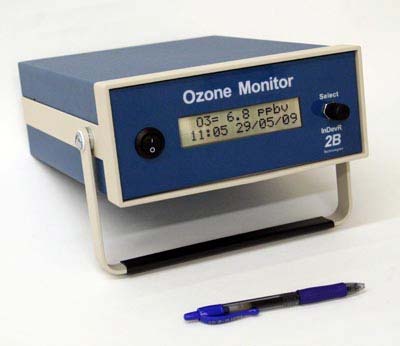
Precise measurements (+/- 2%)
Measures from 0.01 to 250 ppm
Integrated data logger
4-20 mA outputs, RS-232, relays
Single Beam UV Technology
Applications:
- Vertical profiling using balloons, kites, RPVs and light aircraft where space and weight are highly limited
- Long-term monitoring at remote locations where power is highly limited
- Urban arrays of ground-based detectors
- Personal exposure monitoring for studies of health effects of air pollutants
- Environmental health and safety monitoring
- Laboratory studies of the effects of ozone exposure on materials and organisms
Model 205 avec Technologie UV Dual Beam
 Precise measurements (+/- 2%)
Precise measurements (+/- 2%)
Measures from 0.01 to 250 ppm
Integrated data logger
4-20 mA outputs, RS-232, relays
UV Dual Beam Technology
Applications:
- Vertical profiling using balloons, kites, RPVs and light aircraft where space and weight are highly limited
- Long-term monitoring at remote locations where power is highly limited
- Urban arrays of ground-based detectors
- Personal exposure monitoring for studies of health effects of air pollutants
- Environmental health and safety monitoring
- Laboratory studies of the effects of ozone exposure on materials and organisms
The Model 205 Dual Beam Ozone Monitor makes use of two detection cells to improve accuracy, baseline stability, and response time. In the Dual Beam instrument, Io (ozone-scrubbed air) and I (unscrubbed air) are made simultaneously. Combined with other improvements, making our instrument the fastest UV-based ozone monitor on the market, while still retaining the small size, weight, and power requirements of our popular Model 202 Ozone Monitor.
Model 211
Scrubberless Ozone Monitor
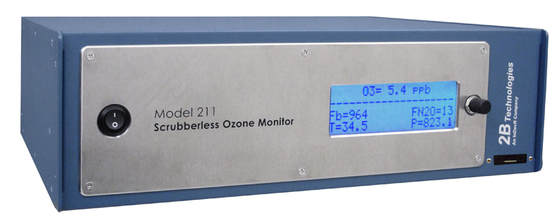
Specifications
- Battery
- External particle filter
- Lamp heater for outdoor operation in extreme environments
- Bluetooth wireless data transmission
- 4-20 mA analog current output
- External serial-to-USB adapter
- High-altitude upgrade allows operation up to 25 km (pressure sensor)
The animation above illustrates the principle of a gas-phase NO scrubber for a single-beam instrument. A small amount (~5 ppm) of nitric oxide (NO; blue) is pulsed into the air flow every 2 seconds to destroy the ozone and produce nitrogen dioxide (NO2; green) which doesn't absorb the UV light. When ozone (red) is present the signal at the photodiode is reduced due to ozone absorbing the UV light. When ozone is destroyed by the NO, the signal increases. The difference in measured light intensities is proportional to the ozone concentration. Because the potentially interfering species (benzene, toluene, xylenes, aldehydes, mercury, etc.; colored yellow) are always present and not modulated by NO, they do not contribute to the signal difference and thus do not interfere with the ozone measurement.
2BTech Ozone Monitor 211 Scrubberless
Model 211-G Ozone Monitor™
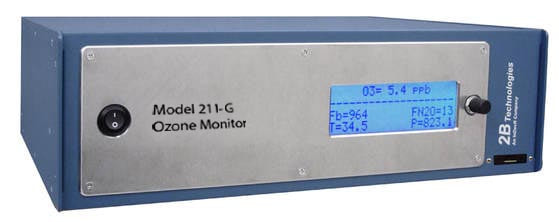
Specifications
- Battery
- External particle filter
- Lamp heater for outdoor operation in extreme environments
- Bluetooth wireless data transmission
- 4-20 mA analog current output
- External serial-to-USB adapter
- High-altitude upgrade allows operation up to 25 km (pressure sensor)
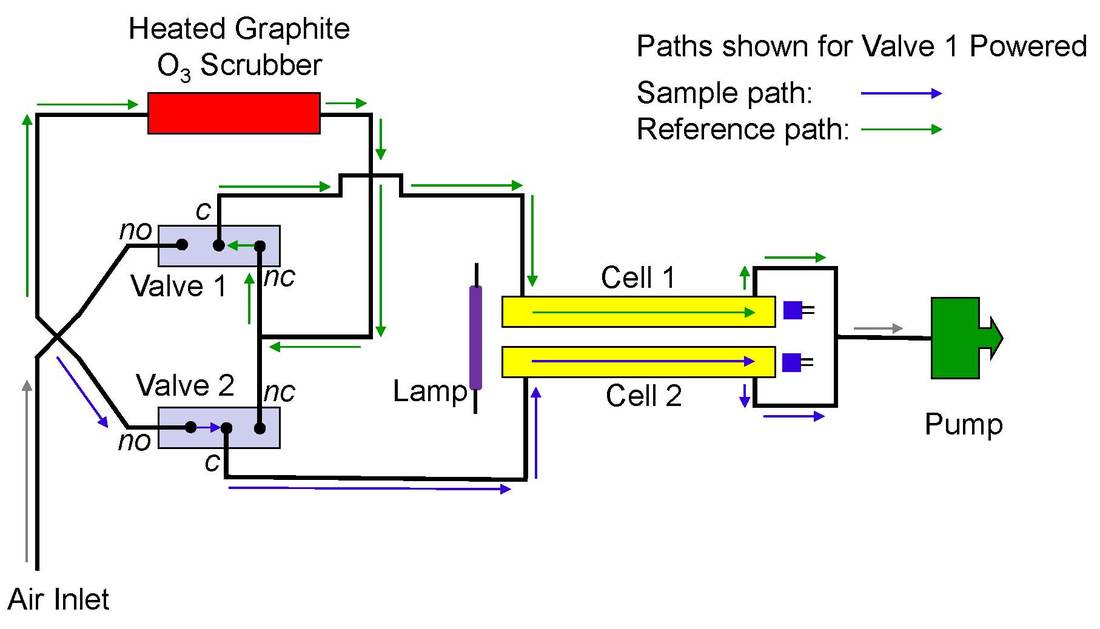 Like our Model 205 Ozone Monitor, the Model 211-G is dual beam, with a measurement of the transmission of UV light through ozone-scrubbed air being made simultaneously with a measurement of UV light passing through unscrubbed sample air, thus increasing the precision and baseline stability of the instrument.
Like our Model 205 Ozone Monitor, the Model 211-G is dual beam, with a measurement of the transmission of UV light through ozone-scrubbed air being made simultaneously with a measurement of UV light passing through unscrubbed sample air, thus increasing the precision and baseline stability of the instrument.
The Mode 211-G allows remote instrument operation via RS-232, choice of averaging time (2 s to 1 hr), analog voltage output (0-2.5 V), optional analog current output (4-20 mA), and an internal data logger. Our data display and graphing software allows continuous display of data which can be saved for offline analysis
Information about monitor 211-G
Ambient NOx Measurements
Model 405 nm NO2/NO/NOx Monitor
Ultra pre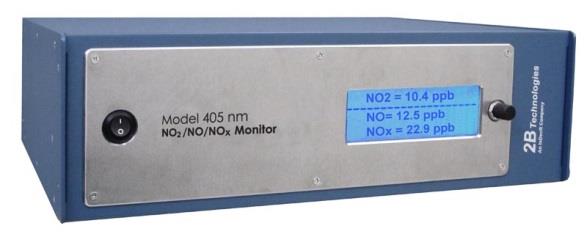 cise measurements (+/- 2%)
cise measurements (+/- 2%)
0 to 2 ppm
Data logger
4-20 mA outputs, RS-232, relays
Tech UV dual beam, scrubberless
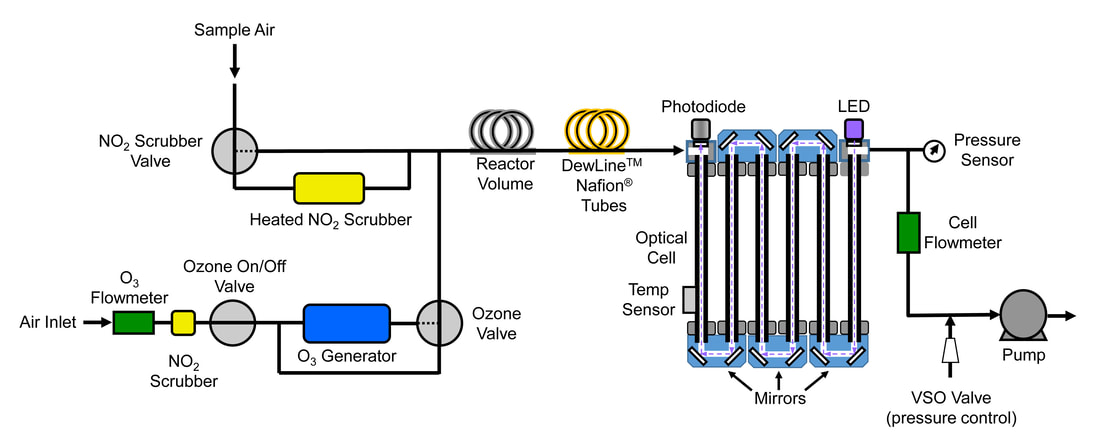 at a flow rate of ~1.5 L/min. The Scrubber Valve alternately bypasses and sends the sample air through a NO2 scrubber to remove all NO2 in the sample, thus allowing the measurement of a light intensity in the absence (Io) of NO2 and presence (I) of NO2. The Beer-Lambert Law is then used to calculate the concentration of NO2 from I and Io.
at a flow rate of ~1.5 L/min. The Scrubber Valve alternately bypasses and sends the sample air through a NO2 scrubber to remove all NO2 in the sample, thus allowing the measurement of a light intensity in the absence (Io) of NO2 and presence (I) of NO2. The Beer-Lambert Law is then used to calculate the concentration of NO2 from I and Io.
Black Carbon Experiment Package
The Black Carbon Photometer™ (BCP™) is a rugged, portable, highly accurate and economical instrument for measuring atmospheric black carbon particulates in polluted urban environments. The BCP uses the simple and direct technique of long-path photometry to quantify—in real time—the total extinction and mass concentrations of particulates in the aerosol (gas + particle) phase. This direct approach avoids the artifacts and other issues associated with current commercially available instruments, such as the most common current technique of aethalometry that uses filters to preconcentrate samples for analysis.
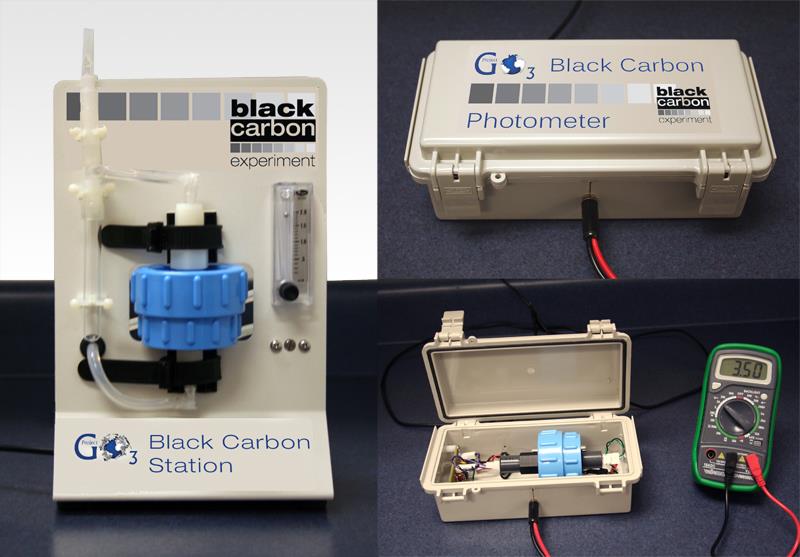
Black Carbon Photometer
2.5A Power Adapter (2.5 amp, 100-240 VAC to 12 VDC) with select power cord
Serial Port Cable (9PinF-9PinF)
Operation Manual on USB Stick
Calibration Data and NIST-Traceable Calibration Certificate
Instrument Birth Certificate
One-Year Warranty
The figure below is a simplified schematic diagram of the Black Carbon Photometer. Sample air is continuously drawn through the instrument and its optical detection cell by an air pump at a flow rate of ~1.0-1.6 L/min. The reference valve alternately bypasses or sends the sample air through a PTFE particulate filter (labeled Particulate Filter #1 below) that removes all particulates in the sample, thus allowing the alternating measurement of a light intensity in the absence of particulates (Io) and presence of particulates (I). The Beer-Lambert Law is then used to calculate the particulate extinction (Bext) from I and Io: Bext = 1/L ln(Io/I)
2BTech Black Carbon Experiment Package
Information about Black Carbon
Calibrators
Model 714 NO2/NO/O3 Calibration Source
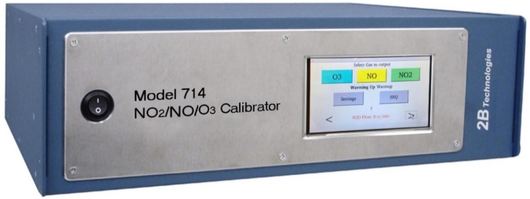 Method of producing UV photolysis of nitrous oxide (N2O) at 185 nm
Method of producing UV photolysis of nitrous oxide (N2O) at 185 nm
Production method for UV photolysis of oxygen (O2) at 185 nm
NO2 production method. 0-500 parts per billion by volume (ppb)
The Model 714 NO2/NO/O3 Calibration Source™ combines the 2B Technologies Model 306 Ozone Calibration Source™ and the Model 408 Nitric Oxide Calibration Source™ to produce calibrated sources of O3, NO and NO2. The Model 714 makes use of two low-pressure mercury lamps, one to photolyze oxygen to produce O3, and a second lamp to photolyze nitrous oxide (N2O) to produce NO. Nitrogen dioxide is produced in the stoichiometric reaction of O3 with excess NO to convert NO to NO2. A schematic of the Model 714 is shown below:
2BTech Calibration Source Model 714
Model 306 Ozone Calibration Source
The 2B Technologies Model 306 Ozone Calibration Source™ is a portable source of ozone that allows you to calibrate any ozone monitor - not just those manufactured by 2B Tech.
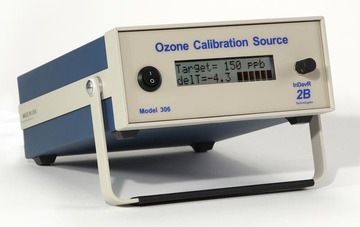
Accuracy and accuracy of performance greater than 2 ppbv
Analog output yes; the voltage output follows the ozone output and provides the system error codes
Serial connection yes; for remote operation and system diagnostics
Applications:
- Calibration of ozone monitors in the field. This highly portable transfer standard is especially useful for maintaining the calibrations of networks of ozone monitors.
- Testing of materials such as rubber, plastics and paint for effects of ozone exposure.
- Studies of the effect of ozone on plants where a calibrated source of ozone is required.
2BTech 306 Ozone Calibration Source
Model 408 NO Calibration Source
The Model 408 Nitric Oxide Calibration Source is a portable source of nitric oxide that allows one to calibrate any nitric oxide monitor.
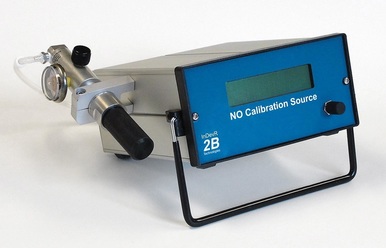 Hightweight, compact, and highly portable source of nitric oxide Calibrate any NO monitor in the field or lab
Hightweight, compact, and highly portable source of nitric oxide Calibrate any NO monitor in the field or lab
NO is free of any significant concentration of NO2
Uses ambient air, producing NO containing same humidity as air sample to be measured
Portable N2O Source eliminates need for compressed-gas cylinders
Can be used as a transfer standard
Low power consumption
The Nitric Oxide Calibration Source makes use of a low pressure mercury lamp to photolyze nitrous oxide (N2O) and produce NO in a patented process.
An air pump forces ambient air through NO and ozone scrubbers to remove any ambient NO and ozone. The air flow rate is controlled by use of restrictors (not shown) and a needle valve that vents part of the flow and is measured by a flow meter. Nitrous oxide is supplied by a cartridge containing liquid N2O with a headspace pressure of ~50 atmospheres. The internal pressure is dropped by a combined cracker/regulator and additional flow restrictor, which also is used to provide coarse adjustment of the flow rate of N2O to be in the range 60 ± 10 cc/min. A pressure relief valve inside the instrument housing prevents over pressurization by opening to the atmosphere if the pressure exceeds 25 psig. A Voltage Sensitive Orifice (VSO) valve is used to provide fine control of the N2O flow rate to ~60 ± 1 cc/min. Within the photolysis chamber, a very small fraction of the N2O is converted to NO and N2 by absorption of light at wavelengths near 185 nm.
Model 408 NO Calibration Source
HERMES Personal Mercury Monitor™
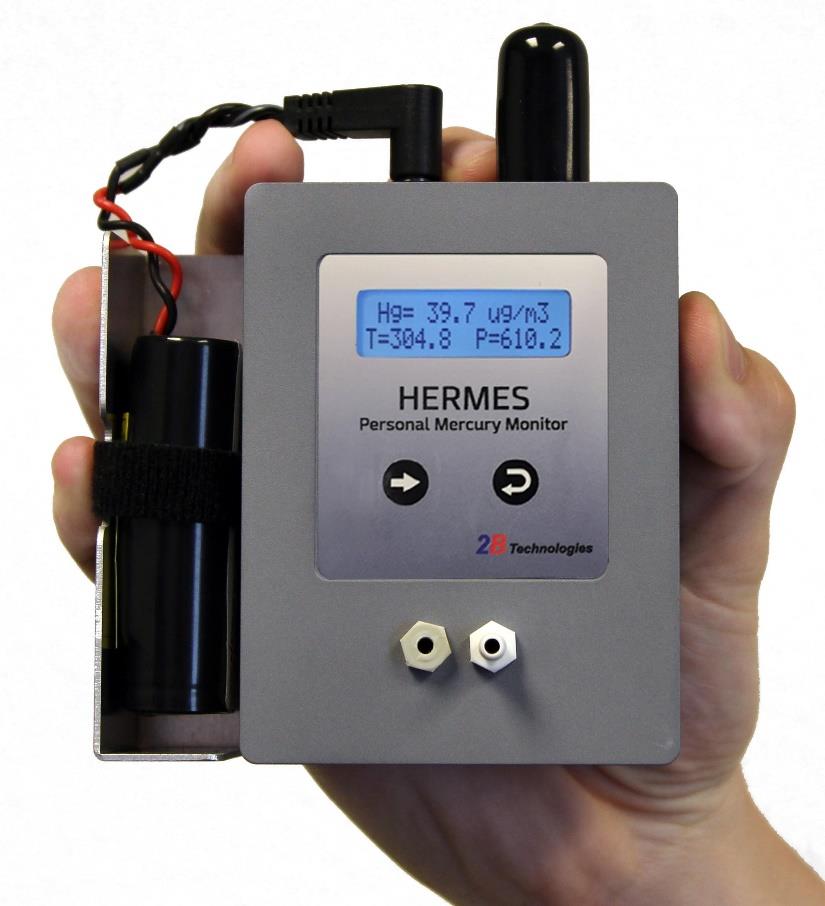
UV absorption: 254mn
Accuracy: +/- 2%
Mercury units ppb, ug m-3
GPS: yes
Applications:
- Monitoring of exposure to individuals in the workplace
- Monitoring and control of mercury in industrial settings
- Personal exposure monitoring for studies of health effects of air pollutants
- Long-term monitoring at remote locations where power is highly limited
2BTech HERMES Personal Mercury Monitor
Accessories
Your benefits ozone.ch
Ozone provides you:
- Customized installations delivered turnkey
- The necessary training
- Technical support
- Supply of reagents and wear parts
- Laboratory analyzes
- A service / maintenance contract


